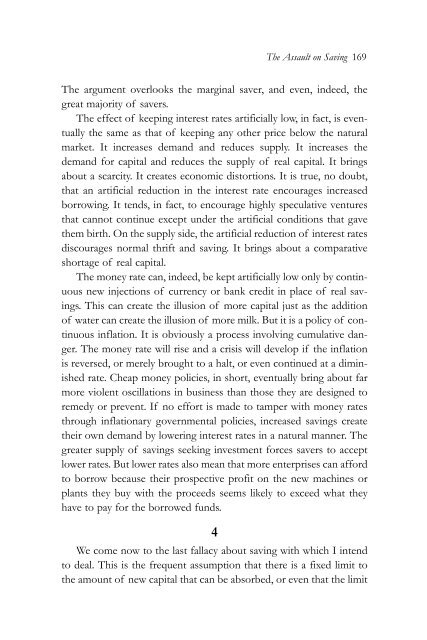1gDdM7w
1gDdM7w
1gDdM7w
- No tags were found...
Create successful ePaper yourself
Turn your PDF publications into a flip-book with our unique Google optimized e-Paper software.
The Assault on Saving 169The argument overlooks the marginal saver, and even, indeed, thegreat majority of savers.The effect of keeping interest rates artificially low, in fact, is eventuallythe same as that of keeping any other price below the naturalmarket. It increases demand and reduces supply. It increases thedemand for capital and reduces the supply of real capital. It bringsabout a scarcity. It creates economic distortions. It is true, no doubt,that an artificial reduction in the interest rate encourages increasedborrowing. It tends, in fact, to encourage highly speculative venturesthat cannot continue except under the artificial conditions that gavethem birth. On the supply side, the artificial reduction of interest ratesdiscourages normal thrift and saving. It brings about a comparativeshortage of real capital.The money rate can, indeed, be kept artificially low only by continuousnew injections of currency or bank credit in place of real savings.This can create the illusion of more capital just as the additionof water can create the illusion of more milk. But it is a policy of continuousinflation. It is obviously a process involving cumulative danger.The money rate will rise and a crisis will develop if the inflationis reversed, or merely brought to a halt, or even continued at a diminishedrate. Cheap money policies, in short, eventually bring about farmore violent oscillations in business than those they are designed toremedy or prevent. If no effort is made to tamper with money ratesthrough inflationary governmental policies, increased savings createtheir own demand by lowering interest rates in a natural manner. Thegreater supply of savings seeking investment forces savers to acceptlower rates. But lower rates also mean that more enterprises can affordto borrow because their prospective profit on the new machines orplants they buy with the proceeds seems likely to exceed what theyhave to pay for the borrowed funds.4We come now to the last fallacy about saving with which I intendto deal. This is the frequent assumption that there is a fixed limit tothe amount of new capital that can be absorbed, or even that the limit


